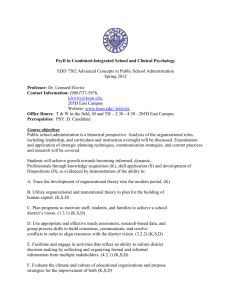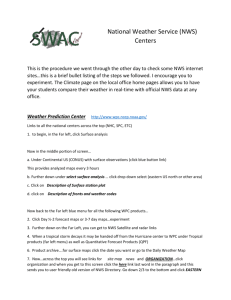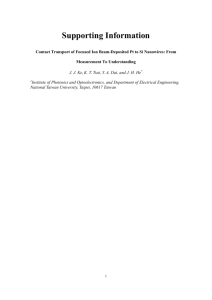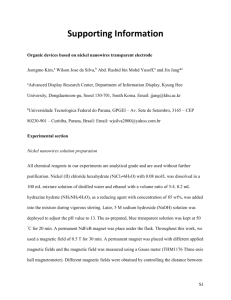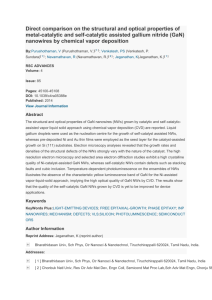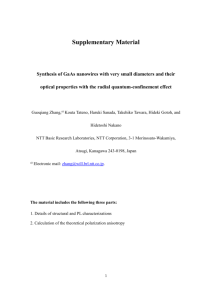Final Report
advertisement
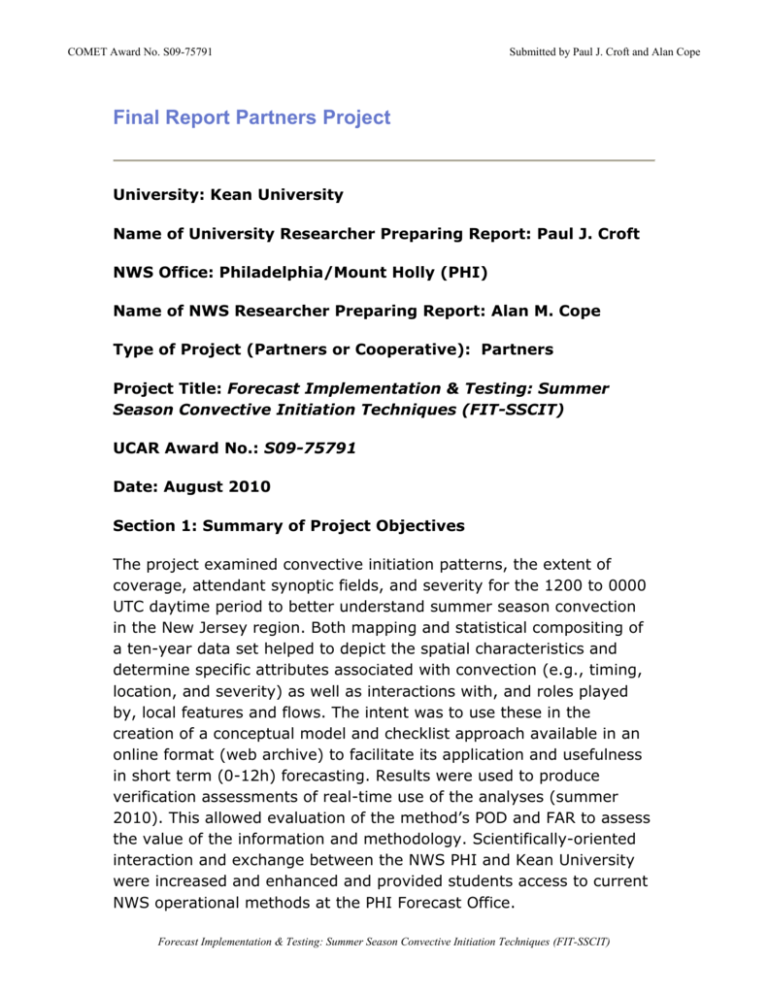
COMET Award No. S09-75791 Submitted by Paul J. Croft and Alan Cope Final Report Partners Project University: Kean University Name of University Researcher Preparing Report: Paul J. Croft NWS Office: Philadelphia/Mount Holly (PHI) Name of NWS Researcher Preparing Report: Alan M. Cope Type of Project (Partners or Cooperative): Partners Project Title: Forecast Implementation & Testing: Summer Season Convective Initiation Techniques (FIT-SSCIT) UCAR Award No.: S09-75791 Date: August 2010 Section 1: Summary of Project Objectives The project examined convective initiation patterns, the extent of coverage, attendant synoptic fields, and severity for the 1200 to 0000 UTC daytime period to better understand summer season convection in the New Jersey region. Both mapping and statistical compositing of a ten-year data set helped to depict the spatial characteristics and determine specific attributes associated with convection (e.g., timing, location, and severity) as well as interactions with, and roles played by, local features and flows. The intent was to use these in the creation of a conceptual model and checklist approach available in an online format (web archive) to facilitate its application and usefulness in short term (0-12h) forecasting. Results were used to produce verification assessments of real-time use of the analyses (summer 2010). This allowed evaluation of the method’s POD and FAR to assess the value of the information and methodology. Scientifically-oriented interaction and exchange between the NWS PHI and Kean University were increased and enhanced and provided students access to current NWS operational methods at the PHI Forecast Office. Forecast Implementation & Testing: Summer Season Convective Initiation Techniques (FIT-SSCIT) COMET Award No. S09-75791 Submitted by Paul J. Croft and Alan Cope Section 2: Project Accomplishments and Findings This project was designed to deliver and test an operationally oriented conceptual model of warm season convective initiation for the CWA and nearby regions of the NWS PHI. The project established, updated, and upgraded a ten-year interactive online archive that depicts the (see http://hurri.kean.edu/~keancast/thunder/thunder.html) expected type, mode, and distribution of thunderstorms for the study region. While the study provided for increased specificity with regard to 0-12h convective forecasting, final diagnostic analyses were being prepared for posting to the website. This precision provided definitive evidence of cause and effect of convective types and distributions as a function of synoptic and meso scale flows and features as well as physiographic effects and interactions. In addition, all data were considered with regard to the severity of convection and resulting local storm reports. While still in final preparation, this data base is posted online in an effort to improve the confidence level of initiation forecasts as well as to provide important risk assessment information for the study region. Kean University students collected, mapped, and prepared the dataset for the period 2000-2009 (test season of 2010) for the creation of the conceptual model and for the verification/testing and were involved in all aspects of the project. The project results online include definition and presentation of event, contaminate, and null cases; the associated analytic fields (e.g., 500 mb geopotential height, precipitable water, et cetera); the distribution of convective initiates based on composite mapping of radar images; and ultimately STP coverage of convective day activity for the first-half [1200-1800 UTC] and second-half [18000000 UTC] of the day; the expected rendition and animation in time of severe reports (i.e. location and type of severe reported to be posted at a later date); and the empirical probabilities (conditional) according to surface synoptic type, 500 mb flow regime, and their combinations. Project accomplishments thus met the scientific outcomes for use in both verification study and direct operational application in real-time. The project accomplishments met related outcomes by delivery of a variety of abstracts for conferences; publication of a preprint and other technical materials; presentations at conferences (and scientific and other audiences); manuscript and proposal development (ongoing); and increased and enhanced exchanges between research partners. Forecast Implementation & Testing: Summer Season Convective Initiation Techniques (FIT-SSCIT) COMET Award No. S09-75791 Submitted by Paul J. Croft and Alan Cope Section 3: Benefits and Lessons Learned: Operational Partner Perspective The accomplishments of this COMET project have direct applicability to forecast operations at the NWS Mount Holly, NJ, forecast office (PHI). Project results, including the conceptual model and above-mentioned web site, have given the forecasters at PHI a better understanding of the initiation and evolution of thunderstorms during summer months for the New Jersey area and vicinity. Results from this project were presented and discussed at local preconvective season workshops in the spring of both 2009 and 2010. Also, the conceptual model was tested operationally for well over a month during the summer of both years. The focus was on the first 12-hour forecast period after the midnight shift (1200-0000 UTC); this fit well with our local enhanced short-term forecast program which began in October of 2009. This project has helped maintain considerable scientific interaction between NWS PHI and Kean University, including many visits by Dr. Croft to the NWS during 2009 and 2010, and a talk by Mr. Cope to the meteorology club at Kean in March 2010. Finally, a related project was conducted at NWS PHI during summer 2010. A Hollings Scholarship student from Millersville University conducted a local study of cloud-to-ground lightning patterns over the New Jersey area during summer months. His analysis included stratification of lightning days according to surface and upper-air patterns, which were determined as part of this COMET project. The resultant lightning flash-density maps have added more detail to our conceptual model of thunderstorm behavior. Section 4: Benefits and Lessons Learned: University Partner Perspective Students were provided multiple opportunities to work in concert with NWS operations with regard to the development and implementation of an operations-based predictive system. Skills from their coursework were useful in this regard and will aid their career and professional development. Some of the work completed was leveraged with the Forecast Implementation & Testing: Summer Season Convective Initiation Techniques (FIT-SSCIT) COMET Award No. S09-75791 Submitted by Paul J. Croft and Alan Cope Honors Seminar coursework students were enrolled in as well as Independent Study and other Kean University student-research programs (e.g., “Students Partnering with Faculty”). These included emphasis on writing, production of figures and tables for publication and professional development. Results have been displayed in the hallway and formed the basis of discussions in synoptic laboratory sessions and other classes in which map discussions and assessments were completed. Outcomes were also presented by students during the Kean University annual “Research Day” during the spring term. Additional student assistance was provided through the Federal Work Study Program at Kean University. The NWS provided guest speakers for lecture and results were also presented during the pre-summer workshop at the PHI NWS office. Leveraging of the project has been accomplished through the Kean University Students Partnering with Faculty Program. This allowed for student work on project activities in advance and in concert with those hired for analytic work and archival data collection. Students involved in the project have presented their results to the Kean University Student Chapter of the AMS/NWA, the College-wide meeting of the College of Natural, Applied, and Health Sciences, and contributed to both oral and poster presentations of the research. Section 5: Publications and Presentations Presentations of the work were made by Croft and/or Cope at several meetings (National Weather Association Conference, October 2009; American Meteorological Society Annual Meeting, January 2010; NWS Eastern Region Radar/Severe Weather Workshop, June 2010). A draft manuscript is in preparation. Results were presented at the NWS spring workshop (PHI office) by both investigators (April 2010). Section 6: Summary of University/Operational Partner Interactions and Roles The two main participants in this COMET project were Dr. Paul J. Croft of Kean University and Mr. Al Cope of the NWS Mount Holly, NJ office. Dr. Croft prepared the original proposal with input from Mr. Cope. Data for the project, including radar imagery and products, synoptic weather charts, etc., were collected by students in the Kean University Forecast Implementation & Testing: Summer Season Convective Initiation Techniques (FIT-SSCIT) COMET Award No. S09-75791 Submitted by Paul J. Croft and Alan Cope Department of Geology and Meteorology under the supervision of Dr. Croft. Radar maps and verification data were also prepared at the NWS Office by summer volunteer students and interns, using the local archive and computer workstation, under the supervision of Mr. Cope. Analysis of results was accomplished and presented by Dr. Croft and Mr. Cope. Forecast Implementation & Testing: Summer Season Convective Initiation Techniques (FIT-SSCIT)

